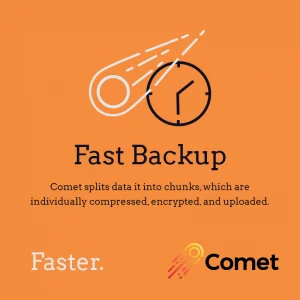Curious about how backup started? We sat down with backup enthusiast and lead developer behind Comet, Mason Giles
Where it all began... tape anyone?
Back in the 60s, computers were called "mainframes" and typically took up most of the space in a room - and even back then, data backup was an issue. Information was stored up on tapes, and the process of backing up and retrieving data was laborious. This was even highlighted in the show "Some Mothers do 'Ave Em" with accident-prone Frank Spencer destroying tapes and eventually the computer itself:
Tape backup was a plausible option for many businesses right through until the mid ‘90s, and magnetic "tape drives" were commercially available for your computers and servers. The usual approach was to buy 5 tapes (one for each day of the working week); and every day you'd bring in last week's tape and record the day's work over it.
But despite a reasonable per-tape cost, it quickly became expensive to scale the concept beyond more than a few days of history – and when you needed something back, you'd have to "play back" the entire tape onto your computer - a long process if you only need to recover a single file!
It was a simple enough solution at the time. Tape drives offered high storage capacity and LTO tapes continue this tradition today. But the era of tape backup will be remembered mostly as being inconvenient to restore data, cumbersome to verify, and - easy to forget!
It was time for a change..
Fast forward (pardon the pun) a few decades to the arrival of something called incremental backup. Instead of taking a full copy of each file, it became possible to determine exactly what had changed since yesterday, and only back up the difference. This reduced the amount of data needed to store each successive backup, making it feasible to send your data to hard drives and network accounts instead of tape - and with a trend of increasing internet speeds worldwide, online backup was born.
This process of backing up to a device or the cloud was certainly more efficient than using tapes. The largest benefit was in automation - no longer did someone have to remember to change the tapes every day. But critically, it became complicated to restore your data. Right when you need it most, recovery now involves restoring the very original file and then applying every modification on top of it. This could require lots of overhead, processing, figuring which pieces fit where - and if one modification is lost or damaged, then the whole system falls down.
Many vendors attempted to paper over some flaws in this basic concept, each taking a step forward but two steps back – don’t get us started on the serious drawbacks of differential backup, in-file diffs, consolidated images, hardlink backup, synthetic full images, or reverse / fast-forward chains...
Comet is the next generation in backup strategy. In fact, you might say that it's a fundamental change in how backup works. Instead of looking at the differences between one day and the next, Comet looks deep into file contents to identify time-invariant chunks.

What's the benefit? Our technology dramatically reduces processing overhead. It minimizes the amount of data transfer and storage for both initial and successive jobs, intelligently handling already-stored content within files, across renames, and variable-length insertions simply as a matter of course. It offers equally fast access to both your latest version and the oldest historical data, without ever needing roll-up operations, meaning encryption and cloud storage work correctly - even with an arbitrary history length.
So, if it's speed you're after, then why not give Comet a try. The only thing restricting you is the speed of your computer and your internet connection. We're really proud of the quick time it takes to install the server and the super-fast time it takes create a backup.